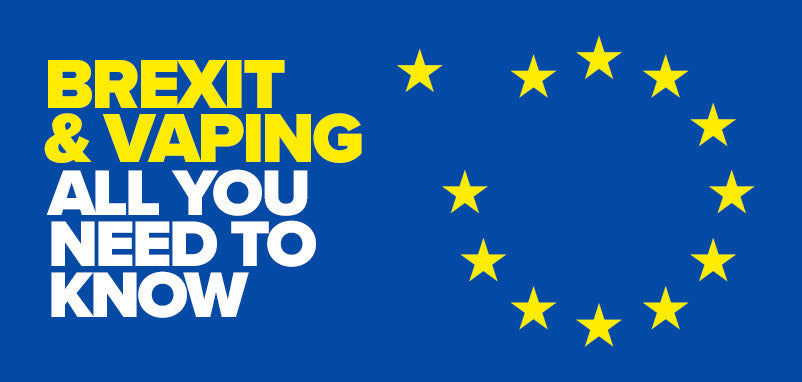
Vaping Regulations After Brexit
Last Updated: Mar 14, 2023 MarielShare
As the UK has now left the European Union, what new regulations could be implemented on vaping products?
We are aware that some of our customers have legitimate concerns about what these changes may be in relation to their vaping experience.
These concerns include:
- Whether young adults under the age of 18 may start vaping
- Vaping products may not be as safe because in non EU countries, such as America, manufacturers do not have to adhere to strict EU guidelines. This explains why vaping is generally more accepted in the UK compared to the States.
We want to shed light on what possible developments may occur as a result of Britain leaving the EU.
The Market
The UK is the second largest market for vaping products. Market Research Euromonitor found that globally, the number of adults vaping jumped up from 7 million in 2011 to 41 million in 2018, this amount is expected to rise to 55 million by 2021. A sizeable portion of these individuals will be British given the popularity of Vaping within the UK.
Therefore, we predict that:
Vaping manufacturers will still have an economic incentive to provide safe and high-quality products for British consumers after Brexit.
Current regulations
The British vaping industry adheres to The Tobacco & Related Products Regulations (TRPR). The UK regulator is the Medicines and Healthcare Products Regulatory Agency (MHRA), which ensures the EU legislation guidelines set by The Tobacco Products Directive (TPD) are met.
The MHRA are responsible for making rules concerning the sale, manufacturing and presentation of tobacco and tobacco related products.
For vaping, this means that the vape tank size, amount of E-Liquid, nicotine strength levels and restrictions on advertising have to be respected.
As Britain has left the EU, these regulations will be subjected to review by the MHRA and the Department of Health and Social Care.
This will create an opportunity for the Government to listen and implement advice given by vape advocacy groups and trade bodies.
They want the Government to:
- Lift restrictions on bottle and tank sizes as well as nicotine strength options.
- Allow them only to comply with guidelines set by the Committee on Advertising Practice (CAP).
- Produce appropriate promotional content which makes vaping more appealing to smokers looking to quit.
- Only have nicotine warning labels placed on products which contain nicotine in them.
At the moment there is a private members bill working it's way through the House of Commons; Electronic Cigarettes (Regulation) Bill for 2019 -2021
Therefore we predict that:
Vaping manufactures may be granted access to advertise their products across a wide range of platforms.
Warning labels on packaging may vary.
The design of vape devices, components and E-Liquid bottles may change.
The MHRA will continue to do their part to ensure that safety regulations are placed on vaping products while advocacy groups and trade bodies will play a role in discarding arbitrary restrictions.
Health related matters
The Tobacco control plan for England set the following objects by 2022:
- To lower the percentage of smoking adults from 15.5% to 12% (preferably less)
- To reduce the amount of 15 year olds smoking regularly
- To reduce the smoking prevalence in low income areas
- To reduce the amount of pregnant women smoking from 10.5 to 6%
This plan did also suggest that a move towards using larger bottles would be preferred instead of using the 10ml bottles.
Currently this plan seems to be effective as there has been a favourable decline in the adult smoking rate in England since it was implemented in 2017.
Other reputable health organisations such as the NHS and Public Health England are also committed to accomplishing a smoke-free society with an adult prevalence of 5% or less by 2030.

Currently, the NHS, PHE, British Heart Foundation and Cancer Research UK, all agree that vaping is a less harmful alternative to smoking and therefore support a smokers decision to switch to vaping as a viable alternative.
While they all support vaping, they urge non-smokers not to take up the activity.
They also do not recommend vaping for pregnant women.
Therefore, we predict that:
Due to the support from Reputable Health Bodies coupled with a Government committed to getting people to quit smoking, there may be advertising and informative data distributed on vaping to help make sure that stopping smoking objectives are met.
Products may become more accessible in an attempt to bridge inequality gaps
Tough regulation will still be in place to ensure minors are not able to purchase tobacco related products.
10ml E-liquid bottles may be replaced.
A harmless vaping product may be created for pregnant women to meet with the objectives set by the Tobacco control plan.
Unlike the USA, the UK has the NHS which motivates the Government to take care of the health of their citizens, thus, they are unlikely to support products which may cause harm and could potentially lead to a financial burden and possible public backlash.
Please let us know what your thoughts on Post-Brexit Vaping are in the comment section below.


6 comments
Hopefully now were the UK again and don’t have to adhere to the European TPD laws, we can get back to more realistic tank sizes instead of 2 ml tanks :-)